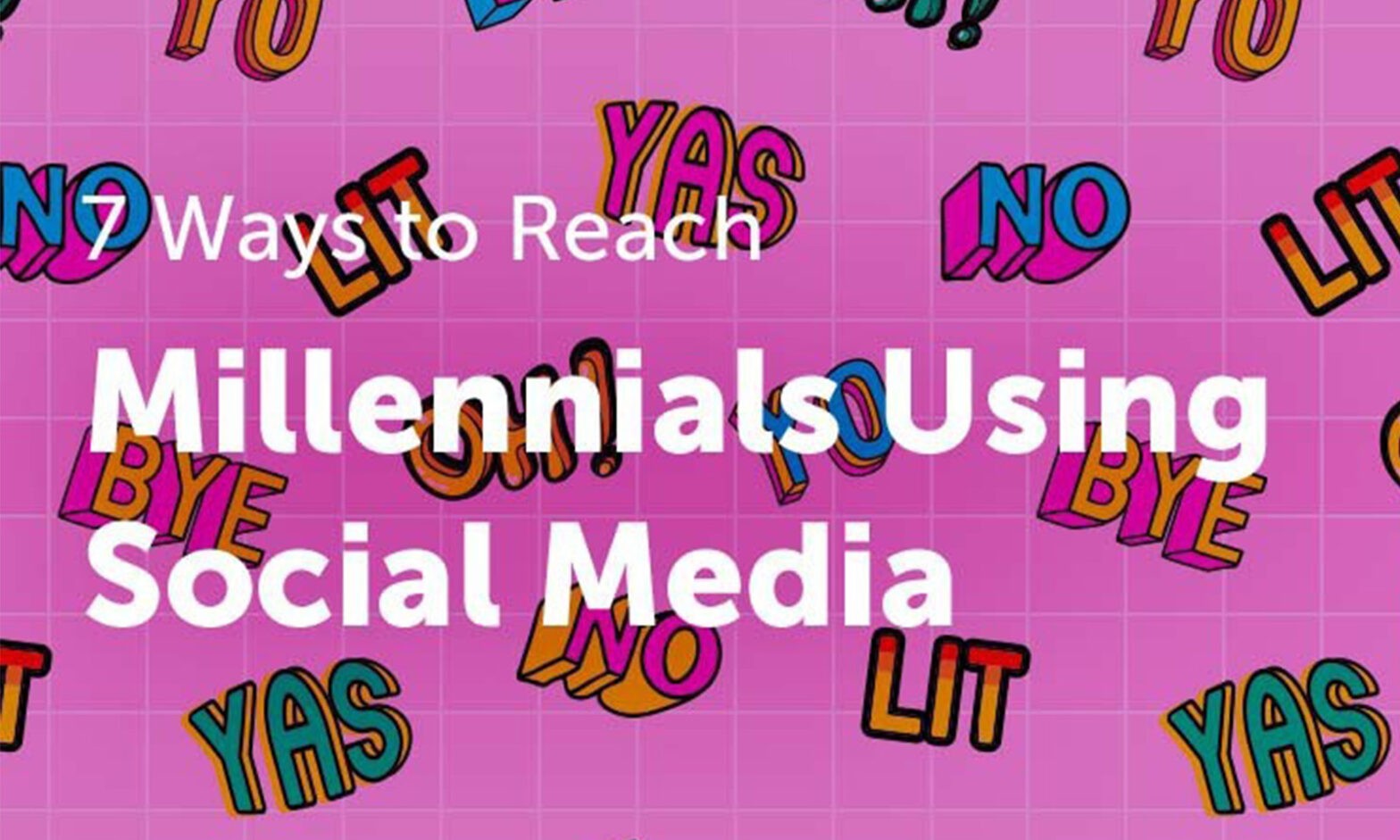For many millennials, social media is a “one-stop-shop” of sorts for news, entertainment, social interaction, education, and just about anything and everything else. With social media firmly established as a staple of millennial life, it’s quickly become a dedicated channel for sales and marketing for all types of brands and businesses.
If one of your target demographics is the millennial generation, social media can be a virtual goldmine of opportunity. But don’t assume that modern-day millennials are the same teens and college kids that were sharing selfies a decade or two ago. Now, millennials are all grown-up – and your tactics for social media marketing to millennials should be too.
What is the age range of millennials?
Before we dive into the how-to of advertising to millennials on social media, it’s important to cover a very common question first: how old are millennials?
According to the Pew Research Center, the millennial generation includes anyone born between 1981 and 1996. As of 2021, that makes millennials a diverse group of individuals aged 25 to 40 – though that can vary slightly, depending on who you ask. Anyone born pre-1980 falls under Gen X (or even the Baby Boomer) generational umbrella, while post-1997 babies are now considered Gen Z.
Researchers from Pew also point out that millennials outnumber Baby Boomers, Gen X, and Gen Z, making them the largest generation in America right now. More than 80% of millennials are active on social media, which adds to a staggering number of potential customers.
And it’s not just sheer numbers that make millennials such a valuable market; they have outstanding purchasing power and tend to be impressively savvy shoppers.
So, if you’re wondering if social media marketing is worth it when it comes to millennials, let’s review:
- Millennials make up the largest generational group in the U.S.
- Most millennials (over 80%) use at least one social media platform, though many report using multiple sites.
- Millennials boast impressive purchasing power, with an estimated $1 trillion-plus in direct buying power.
- In addition to their own purchasing power, millennials are influential in the buying decisions of older generations.
In other words, if your target customers include millennials, you should be using social media to market now – so let’s get to it.
How to Reach Millennials with Social Media Marketing: 7 Practical Strategies

Whether or not social media marketing is effective isn’t the question. Instead, the question is what are the best social media marketing strategies for reaching and influencing millennials?
There are many ways to leverage social media platforms like Instagram and Facebook for marketing, and it’s likely that your options will only continue to expand as the medium evolves. For now, here are seven solid strategies to market to millennials on social media.
1. Understand what millennials care about and why it matters.
Somehow, millennials ended up with a reputation as a generation obsessed with online “likes,” new technology, and selfie-centric culture.
This stereotypical image misses the mark in so many different ways, but its biggest failure is just how much it oversimplifies an incredibly interesting, involved, and passionate generation of Americans.
Because many millennials have literally grown up in the age of modern tech, marketers have been able to glean an outstanding amount of information about what this generation values most. And when it comes to the conversations that millennials are having online, there are a handful of core values that come up time and time again:
- Animal rights
- Environmental sustainability
- Protection for the environment
- Anti-racism
- Inclusivity
- Feminism
- LGBTQ rights
These values also play an important role in how millennials shop: about half of millennials say they would rather purchase from a brand that puts their dollars towards a cause.
For brands, this translates to a need to demonstrate authentic – not just performative – support for the causes and movements that millennials consider important to our world. The brands that are able to do this in a truly genuine and effective manner are better-positioned to connect with millennials, both on social media and in general.
Above all, this tactic can’t be something you attempt solely for appearances’ sake. Millennials aren’t a group that can be easily duped, and half-heartedly supporting a cause can easily harm your brand’s reputation and business.
Instead, find a cause that you believe aligns with your brand values, then take actionable steps to do your part. Share your efforts on social media, providing users with the opportunity to join you in showing their support by making a purchase, sharing a post, or completing another action.
2. Put demographic and behavioral data to good use.
One of the biggest benefits of social media marketing is the volume of useful insights and analytics you can use to optimize your campaigns. In fact, this data isn’t just an advantage; it’s a necessity for brands that want to stay one step ahead of their competition.
Your social media insights give you a clear view of your target millennial audience and exactly the defining characteristics of your niche users. However, there is one caveat to using data for marketing on social media – there’s a lot of data, and it can get complicated pretty quickly. This makes manual analysis incredibly time-consuming, if not impossible.
But with a well-engineered social media monitoring tool (or better yet, a social media marketing expert on your side), you can boil the data down to the details that are directly connected to your goals.
Then, you’ll be better equipped to flesh out your audience’s interests, opinions, online shopping experiences, behaviors, and more. With these insights, you can zoom in on the niche segment of millennials that wants and needs what your brand can offer… and even better, you can get to know them very well and develop a targeted marketing plan accordingly.
There’s not necessarily a single “best” targeting option for millennial marketing, but there are a few that tend to be used regularly by a broad range of brands:
- Behavioral patterns: Did you know that nearly 70% of millennials say they crave adventure in their daily lives? That seemingly random fact represents a vital characteristic of millennial behavioral patterns and purchasing desires. “Adventure” doesn’t have to equal adrenaline-rushing thrills; it can simply mean seeking out small but novel experiences on a regular basis.For example, brands that sell monthly subscription boxes have crafted a fun sense of anticipation surrounding the mystery contents that subscribers receive each month, using social media to build excitement and draw in new and curious customers.
- Advanced targeting parameters: Millennials are a massive generational group, which is a perk for marketing – but it’s also a challenge. The diversity of ages, education levels, and even life experiences of millennials make it impossible to design a single advertising campaign that would connect to them all.When you consider the differences between a 25-year-old recent college graduate and a 40-year-old parent of three, the contrast is clear. This has a major impact on how, where, and when you connect with your audience. Ideally, you’ll design social media campaigns suited to a specific niche group within the generation (for example, millennial parents of children under age 3) to achieve the best results.
- Location, location, location: It might seem overly obvious to say that millennials around the world aren’t all exactly the same, but it’s still a point worth making. For example, a millennial located in a small Southern town in the U.S. is almost guaranteed to be very different from a millennial living in Tokyo, Japan.The social media marketing tactics that succeed in one region of the world or country aren’t going to work in another, so localization is critical.
3. Take a proactive approach to your social media presence.
Whereas previous generations placed value on the in-person interactions at a brick-and-mortar business, millennials expect quality service in an online setting.
It’s not enough to set up a social media page and then forget about it because you could be missing countless opportunities to serve both potential and existing customers.
From comments and shares to questions and complaints, millennials interact with brands and businesses in a myriad of ways on social media. But if you fail to acknowledge and/or respond in a timely manner, they lose interest – and your brand’s reputation is marked.
Millennials are far less likely to contact customer service with questions or concerns and instead head to social media. According to a recent Microsoft study, nearly half of millennials utilize social media for lodging complaints about the services provided by a brand.
That’s a huge chunk of your target market going online to get in touch with your business. And to further complicate things, they could be signing on to any one of several different social media sites: Facebook, Yelp, Instagram, Twitter, and others.
This is why it’s important to be proactive and maintain a consistent presence on various sites, specifically those your audience frequents most.
Regardless of how you choose to manage your social media interactions, staying on-brand, professional, and positive is vital. Of course, professional doesn’t have to mean bland and boring.
Many famous brands have crafted a unique personality on their social media sites while still maintaining a high level of service quality. Oftentimes, it can be productive to set up brand guidelines for your social media activities so that you know exactly what type of presence you want to work towards – and what it will look like when you succeed.
4. Turn user-generated content into a marketing asset.
Balancing your ad spend and ROI on social media can be tricky, especially with many platforms raising paid advertising costs.
But what if we told you that there were ways to build your online credibility, expand brand awareness, and earn higher impressions while cutting your spending?
With user-generated content (UGC), savvy brands can absolutely turn this pipe dream into a marketing reality. So, what is user-generated content? It can take on a variety of forms, including:
- Photos, “stories,” videos, and posts your brand has been tagged in
- Testimonials and customer reviews
- Photos or videos geotagged with your physical business location
This content typically comes at no cost to you but can go extremely far in terms of social proof.
When you find UGC for your brand, make sure you get permission to re-share it on your platforms.
Depending on the form of content, you can credit the original user using an active tag or another method. In many cases, posting user-generated content can inspire other people to create their own content about your brand because they also want to be featured on your page(s).
5. Step into the future of shopping with social commerce.
Let’s say a user finds your brand while browsing Facebook and decides they want to buy something on your e-commerce site – how many hoops do they have to jump through to complete their purchase?
In many cases, the process requires several clicks and a series of processes. And as a result, bounce rate and cart abandonment numbers end up being higher than you’d like.
But with social commerce now in full swing, you can easily put users on the fast track to purchase. They won’t even have to navigate away from the platform, streamlining the user experience and helping you achieve higher conversion and engagement rates.
Each social platform has taken its own approach to social commerce, and it may require a certain amount of time and effort to get your brand set up and ready for shoppers. However, there’s no doubt that social commerce is slated to change the way we buy online… and we’re betting you don’t want to miss out.
6. Consider influencer marketing.
Online influencers have the kind of reach that many brands can only dream about, with the ability to communicate a message to hundreds of thousands of people at a time. Even “micro-influencers” (those with significantly smaller followings) can be an ideal conduit between your brand and a diverse audience.
Not all influencer-brand partnerships are created equally, and selecting one that fits your brand and campaign goals is key. For example, if your business sells organic baby food, working with a fashion influencer with no children isn’t a good match. You won’t just be disappointed by the non-existent results of a campaign with the wrong influencer; you could even see your brand’s reputation negatively impacted in the long run.
As we’ve mentioned before, millennials are a highly intelligent group. They can see inauthenticity coming from a mile away and have no problem ending their relationship with a brand they perceive as dishonest. You’ll need to do your research to ensure that the influencer you’re considering partnering with has an online image you’re ready to align your brand with.
7. Have fun with humor.
You’d be hard-pressed to find anyone that doesn’t enjoy discovering a hilarious new meme, goofy TikTok video, or a clever tweet gone viral. Humor is one of the great uniting forces in the online world, and it can also be a hugely valuable tool for marketers.
When used effectively, humorous content can bring lightness to your marketing message and a relatable element to your brand’s online personality.
With a marketing strategy that incorporates humor, your brand can capitalize on trending topics, react to current events, and drive positive engagement – all while setting your business apart from competitors.
Conquer Social Media Marketing for Any Audience with V Digital Services

Few brands can’t benefit from an effective strategy for social media marketing, whether or not millennials are a part of their target audience. And yet, for many businesses, getting active on social media can be intimidating.
After all, no brand wants to be the next one going viral for a social media misstep. But with the right strategies and an experienced team behind you, you can leverage Facebook, Instagram, LinkedIn, and other platforms to achieve a marketing win.
V Digital Services is your source for all things digital marketing, as well as your go-to experts for developing, implementing, and optimizing a well-rounded strategy for online advertising. We’ll help you map out the best way to connect with your social media following and how to dovetail those efforts with other marketing campaigns for the greatest possible payoff.
Contact the social media strategists at V Digital Services now if you’re ready to reach, influence, and solidify a loyal brand following on social media and beyond.
Image Source: InnaPoka / DisobeyArt / Look Studio / FunnyVectorForYou / Vane Nunes / Shutterstock


 PREVIOUS
PREVIOUS